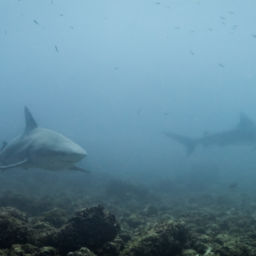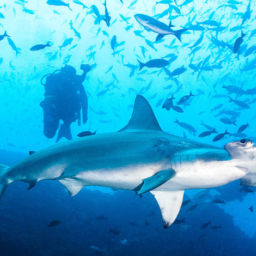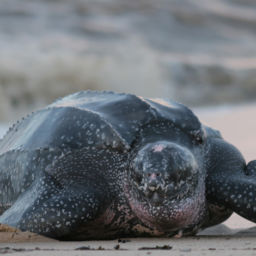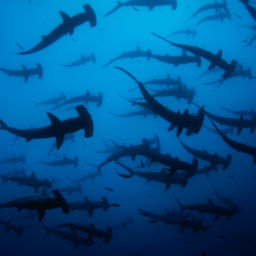Before I went to Cocos Island in Costa Rica, I had plenty of questions about this storied destination. To that end, here’s the download on what you need to know before you visit.
Where is Cocos Island exactly?
Cocos Island, a part of Costa Rica, lies approximately 340 miles (550 km) off the southwest coast of Costa Rica in the Pacific Ocean — pretty much in the middle of nowhere. Which is perfect.
What is it like?
Cocos is lush and green, covered in waterfalls cascading down hillsides and cliff faces. It’s basically “Jurassic Park” without the dinosaurs.
How do I get there?
There are no airports on Cocos, and it can take up to 36 hours by boat, each way, from Puntarenas, Costa Rica to get there and back. Consequently, you’ve got to book a liveaboard dive trip if you want to visit. (Oh darn, right?)
You’ll arrive first in San Jose, Costa Rica and spend the night. The next morning, a shuttle bus run by your liveaboard will come pick you up for the 1.5-hour journey to Puntarenas on the southwest coast. From there, you’ll board the liveaboard for the 36-hour ride out to Cocos. Don’t forget your Kindle or a deck of cards.
That’s such a long boat trip — is it worth it?
Don’t you worry — every minute of that 36 hours is worth it. Part of what makes Cocos special is its isolation. Liveaboard dive boats are pretty much the only visitors to this island, so you’ll have dive sites entirely to yourself. There’s no one and nothing around — just you, your liveaboard companions and a vast blue expanse of ocean.
How big is the island? Does anyone live there?
Cocos is approximately 9 square miles (23.85 km2). It’s been a national park since 1978, largely to protect the marine environment. As such, there are no permanent residents, only Costa Rican park rangers, who work on a month-on-month-off basis.
Can I stay on the island?
Nope, sorry. There are no hotels or facilities for overnight guests on the island.
Okay then, can I at least visit?
You can and you should. Your liveaboard will organize a day-trip to the island, weather permitting, to see where the park rangers live and to get an idea for the topography. You’ll also visit, and walk across, the Genio River Bridge, constructed entirely of the nets, lines and buoys that rangers have confiscated from illegal poaching operations.
What exactly makes the diving so special?
Because it’s the only game in town, Cocos attracts all manner of pelagic life. It’s also part of a migratory superhighway that includes the Galapagos and Malpelo Island off of Columbia, so you can expect many of the same types of animals: schools of hammerheads, whale sharks, silky sharks, Galapagos sharks, whitetips, nurse sharks, tiger sharks, and all manner of rays. Some animals are more seasonal than others, but lots and lots of hammerheads are pretty much a sure bet.
What are the dive conditions like?
Most dives take place from 60 to 130 feet (18 to 40 m). Water temperatures average from 79 F to 84 F (26 to 29 C), so you’ll want either a 3 mm or 5 mm full wetsuit. Hoods keep you warmer for repetitive diving, and gloves are a must. Visibility changes throughout the year, but averages 60 to 100 feet (18 to 30 m).
How many dive sites are there?
Although there are 21 sites, you’ll typically dive four or five sites multiple times over the course of the week, depending on where the action is. The most famous — and prolific — sites are the seamounts at Dirty Rock, Bajo Alcyone and the three sites clustered around Manuelita Island. Although you will repeat dive sites, there’s something new to see on every dive.
How many dives will I do per day?
It depends on your operator, but Undersea Hunter’s two boats each conduct three dives per day at Cocos: two in the morning and one after lunch. Night dives are no longer offered at Cocos since a tiger shark attack in November 2017 resulted in a diver’s death. Consequently, and as a precaution, operators suspended night dives for safety reasons.
Wait…what? Is it safe??
This is the ocean and we can’t make any promises, but yes, you will almost certainly be perfectly safe. Over thousands and thousands of dives and thousands of divers since the 1990s, the attack in 2017 is the only one on record. Since it occurred, dive protocol at Cocos has changed as well. Undersea Hunter dive guides now carry long PVC-pipe “shark sticks” that they can use to move an overly-curious shark along. Divers now stay close together as well, descending and surfacing all together. Although I saw tiger sharks during my visit, none were aggressive in the least.
What about the dive conditions? I’ve heard they’re pretty challenging.
Cocos does have quite a reputation when it comes to raging currents. Some sites, such as Bajo Alcyone, nearly always exhibit a pumping current — which is what draws in the life — so it’s best to come prepared both mentally and physically. If you are diving in a strong current, you’ll need to be able to pull yourself, hand-over-hand, along a tow line on the surface and down a mooring line until you reach the top of the site. Once you get to depth, you’ll find a piece of rock or sheltered cranny and tuck yourself in to watch the show. Gloves are an absolute must, both for rope handling and pulling yourself along the bottom along the rocks. Reef hooks are uncommon in Cocos.
To further safety goals, all guests on Undersea Hunter liveaboards receive both a Nautilus Lifeline and a safety kit, which includes an SMB, a whistle and dive light, to use for the week, free of charge.
What are the dive profiles like?
Most, if not all, dives are deep, starting in around 75 feet and going down to around 110 feet (23 to 33 m). Thus, you’ll definitely want to use nitrox, which is included on Undersea Hunter vessels. If you’re not nitrox-certified before you book your trip, make sure to complete the course before you actually arrive. Dives all begin with a back-roll off a panga. The divemaster or boat captain will tell you when to jump, and you must be ready on his mark due to currents. If you miss your jump, wait until the captain or divemaster gives you the signal again so that you can descend as close as possible to the site.
If you’re diving in relatively mild currents, you and your dive companions will all complete a free descent to the site. And if you’re in a strong current, divers will jump one at a time, tow line in hand. As mentioned above, you’ll need to be strong enough to pull yourself along the tow line in a current until you reach the mooring line. From there you’ll need to pull yourself down the mooring line until you get to the bottom, where the current will generally ease up.
So, who is Cocos Island best for?
Because most, if not all, dive sites are deeper than 60 feet (18 m) you’ll want at least an Advanced certification to come to Cocos. You may also want to consider obtaining a Deep Diver specialty as well. There’s no set number of dives you must’ve done, although Undersea Hunter recommends at least 25 hours underwater, not including class time. You must be confident in currents as well, and good buoyancy is essential.
What if something goes wrong?

You must have diving insurance to visit Cocos, which covers many of the costs and logistics should you need medical care. That said, you’re 36 hours from land, so the best plan is to dive safely and within your limits. If a dive feels too challenging or you’re uncomfortable in any way, sit it out.
When should I go?
The rainy season in Cocos, from July through September, can make for some choppy crossings and challenging conditions, but this is also your best time of year to spot gigantic schools of hammerheads. From December through April, seas are calmer, water is warmer, and skies are sunnier. There’s also great vis during this time, and the best chances for viewing bait balls, but perhaps a bit less hammerhead action underwater. Shoulder season, from May through June and October through November, is a great time to come for the best of both worlds.
What boat should I choose?
Both the Argo and Sea Hunter are well-equipped, sparkling clean, safe, friendly dive boats. The Argo underwent a full refit and refurbishment in 2008 and is also home to the DeepSee Submersible, wherein for an extra fee you can dive down to 1,500 feet (400 m) inside the sub with a pilot. Guests on the Sea Hunter can also book a trip on the submersible, provided all the Argo guests who want to give it a try have done so and that both boats are at Cocos at the same time. The Argo can accommodate 18 passengers; the Sea Hunter 20. You won’t go wrong with either boat.
















